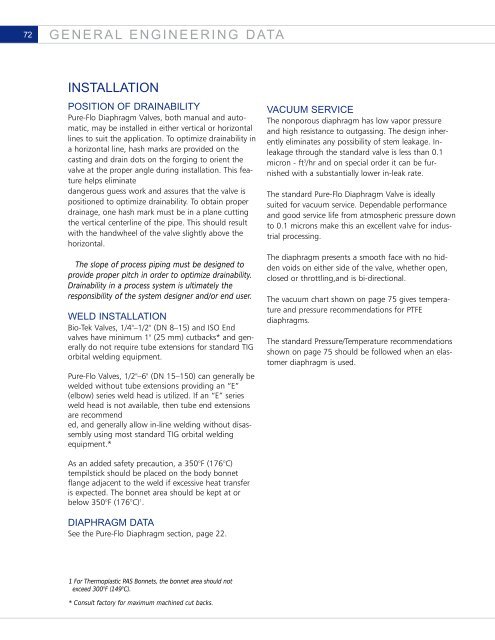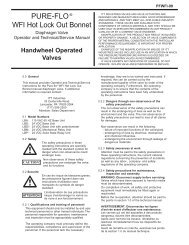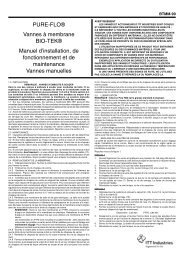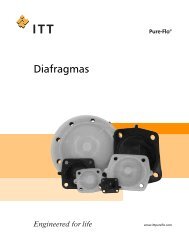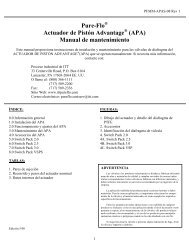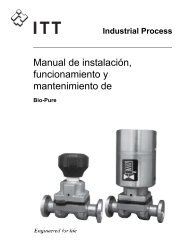Create successful ePaper yourself
Turn your PDF publications into a flip-book with our unique Google optimized e-Paper software.
72 GENERAL ENGINEERING DATA<br />
INSTALLATION<br />
POSITION OF DRAINABILITY<br />
<strong>Pure</strong>-Flo Diaphragm Valves, both manual and automatic,<br />
may be installed in either vertical or horizontal<br />
lines to suit the application. To optimize drainability in<br />
a horizontal line, hash marks are provided on the<br />
casting and drain dots on the forging to orient the<br />
valve at the proper angle during installation. This feature<br />
helps eliminate<br />
dangerous guess work and assures that the valve is<br />
positioned to optimize drainability. To obtain proper<br />
drainage, one hash mark must be in a plane cutting<br />
the vertical centerline of the pipe. This should result<br />
with the handwheel of the valve slightly above the<br />
horizontal.<br />
The slope of process piping must be designed to<br />
provide proper pitch in order to optimize drainability.<br />
Drainability in a process system is ultimately the<br />
responsibility of the system designer and/or end user.<br />
WELD INSTALLATION<br />
Bio-Tek Valves, 1/4"–1/2" (DN 8–15) and ISO End<br />
valves have minimum 1" (25 mm) cutbacks* and generally<br />
do not require tube extensions for standard TIG<br />
orbital welding equipment.<br />
<strong>Pure</strong>-Flo Valves, 1/2"–6" (DN 15–150) can generally be<br />
welded without tube extensions providing an “E”<br />
(elbow) series weld head is utilized. If an “E” series<br />
weld head is not available, then tube end extensions<br />
are recommend<br />
ed, and generally allow in-line welding without disassembly<br />
using most standard TIG orbital welding<br />
equipment.*<br />
As an added safety precaution, a 350°F (176°C)<br />
tempilstick should be placed on the body bonnet<br />
flange adjacent to the weld if excessive heat transfer<br />
is expected. The bonnet area should be kept at or<br />
below 350°F (176°C) 1 .<br />
DIAPHRAGM DATA<br />
See the <strong>Pure</strong>-Flo Diaphragm section, page 22.<br />
1 For Thermoplastic PAS Bonnets, the bonnet area should not<br />
exceed 300°F (149°C).<br />
* Consult factory for maximum machined cut backs.<br />
VACUUM SERVICE<br />
The nonporous diaphragm has low vapor pressure<br />
and high resistance to outgassing. The design inherently<br />
eliminates any possibility of stem leakage. Inleakage<br />
through the standard valve is less than 0.1<br />
micron - ft 3 /hr and on special order it can be furnished<br />
with a substantially lower in-leak rate.<br />
The standard <strong>Pure</strong>-Flo Diaphragm Valve is ideally<br />
suited for vacuum service. Dependable performance<br />
and good service life from atmospheric pressure down<br />
to 0.1 microns make this an excellent valve for industrial<br />
processing.<br />
The diaphragm presents a smooth face with no hidden<br />
voids on either side of the valve, whether open,<br />
closed or throttling,and is bi-directional.<br />
The vacuum chart shown on page 75 gives temperature<br />
and pressure recommendations for PTFE<br />
diaphragms.<br />
The standard Pressure/Temperature recommendations<br />
shown on page 75 should be followed when an elastomer<br />
diaphragm is used.


